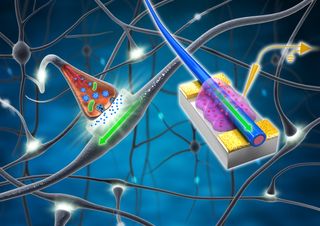New 'Artificial Synapses' Could Let Supercomputers Mimic the Human Brain

Large-scale brain-like machines with human-like abilities to solve problems could become a reality, now that researchers have invented microscopic gadgets that mimic the connections between neurons in the human brain better than any previous devices.
The new research could lead to better robots, self-driving cars, data mining, medical diagnosis, stock-trading analysis and "other smart human-interactive systems and machines in the future," said Tae-Woo Lee, a materials scientistat the Pohang University of Science and Technology in Korea and senior author of the study.
The human brain's enormous computing power stems from its connections. Previous research suggested that the brain has approximately 100 billion neurons and roughly 1 quadrillion (1 million billion) connections wiring these cells together. At each of these connections, or synapses, a neuron typically fires about 10 times per second.
In principle, the human brain can perform about 10 quadrillion operations per second. In comparison, the world's fastest supercomputer, Tianhe-2 in China, is capable of carrying out up to about 55 quadrillion calculations per second, according to the TOP500 project, which ranks the 500 most powerful computers in the world. However, previous research suggests that the human brain consumes only about 20 watts of power, which is barely enough to run a dim light bulb, whereas Tianhe-2 consumes about 17.8 megawatts of power, which is enough to run about 900,000 such light bulbs, TOP500 notes. [7 Clever Technologies Inspired by Nature]
Scientists would like to build computers that mimic the human brain's power and efficiency. "Development of artificial synapses with comparable behaviors of biological ones will be a critical step," Lee told Live Science.
Until now, artificial synapses consumed much more energy than biological synapses do. Previous research suggested that biological synapses consume about 10 femtojoules every time a neuron fires. Now, Lee and his colleagues have created artificial synapses that require only about 1.23 femtojoules per synaptic event, making them the lowest-energy artificial synapses developed yet, they said. (For comparison, a small apple falling about 3.3 feet (1 meter) to Earth would generate about 1 quadrillion femtojoules of kinetic energy.)
This research suggests that the "energy consumption and memory density of artificial brains will ultimately rival, and even exceed, [those of] biological brains in the future," Lee said.
Sign up for the Live Science daily newsletter now
Get the world’s most fascinating discoveries delivered straight to your inbox.
These new artificial synapses are a kind of transistor, or electronic switch. By flicking on and off, they can mimic how a synapse fires.
The researchers fabricated 144 synaptic transistors on a 4-inch (10-centimeter) wafer. At the heart of these devices are wires that are 200 to 300 nanometers (billionths of a meter) wide. (For comparison, the average human hair is about 100,000 nanometers wide.) The small features of the devices help to lower the amount of energy they consume, the researchers said. [5 Amazing Technologies That Are Revolutionizing Biotech]
The new devices are made out of one kind of organic material wrapped around another. These materials help the artificial synapses trap or release electrically charged ions, mimicking how biological synapses work, and how an electric switch can be flicked on or off, the researchers explained.
The artificial synapses mimic the structure of actual human nerve fibers' long shape and flexibility. In principle, the researchers could also arrange these devices in 3D grids, somewhat imitating the human brain, Lee said. However, advances in 3D printing are needed to create such 3D grids of artificial synapses, he added.
The researchers are now working to develop organic nanowires only a few dozen nanometers wide, Lee said. They also think that they can reduce synaptic transistor energy consumption even further by tinkering with the selection and structure of the materials they use, he added.
The scientists detailed their findings online June 17 in the journal Science Advances.
Original on Live Science.

